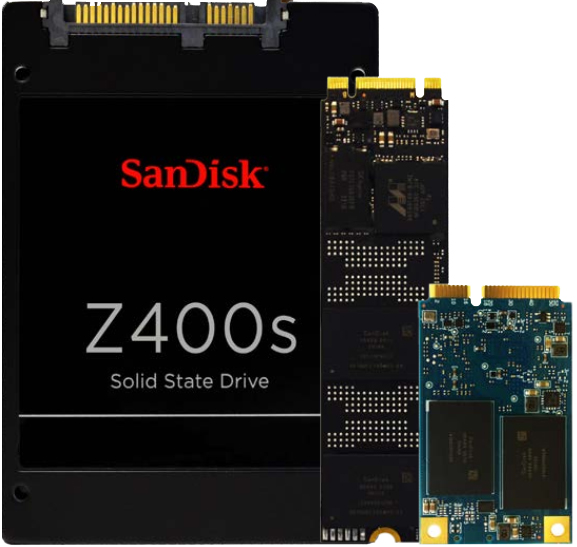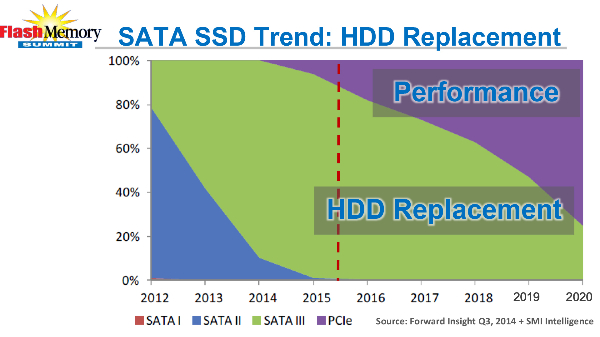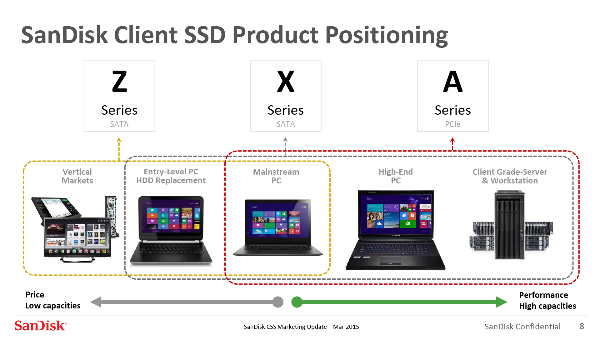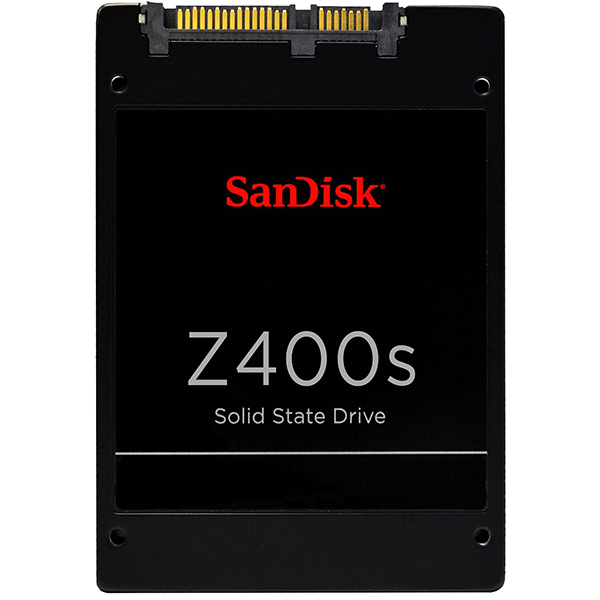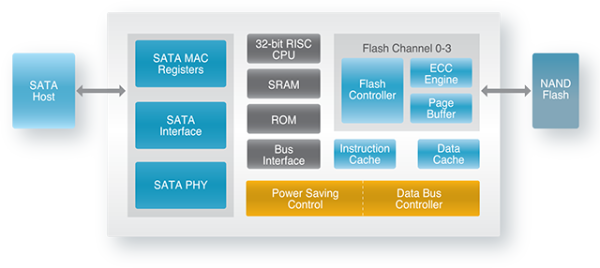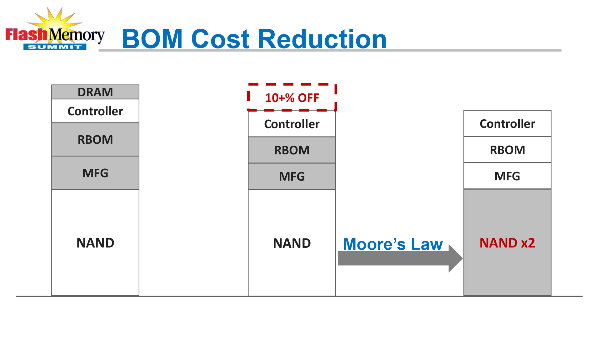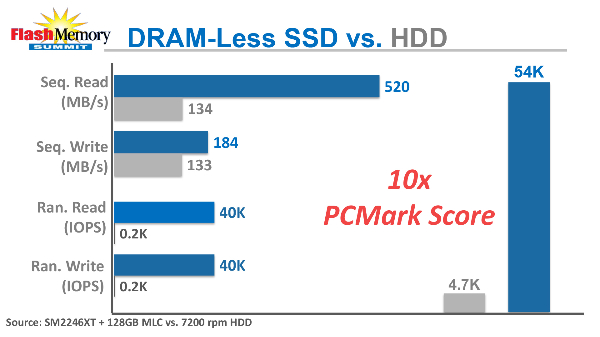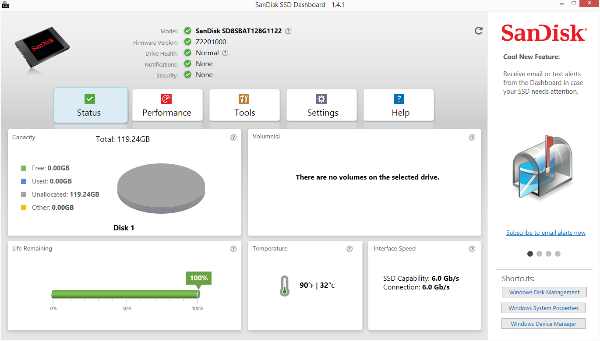Early Verdict
I really liked the Z400s 128GB at 25 cents per gigabyte. I don't know what happened to that price, but it appears to be gone now. At $44.99, the price is still low compared to many of the other products on the market. However, there are some drives with equal pricing, better performance and a DRAM buffer to keep write performance high.
Pros
- +
At $44.99, the Z400s is a very low-cost SSD. It's at least five times faster than a hard drive with random data and has consistent sequential performance under light workloads.
Cons
- -
The Z400s is also much smaller than a hard drive. Performance isn't everything, unless it's either a lot of performance or a lot of capacity.
Why you can trust Tom's Hardware
Specifications, Pricing, Warranty And Accessories
Just a few weeks ago, we saw SanDisk's Z400s on sale in an almost unbelievable bundle. For $128, you could get four 128GB drives, dividing out to 25 cents per gigabyte of flash. A friend of ours took the bait and purchased a pack. If the drives turn out to be duds, he at least has a good story and some nice-looking coasters.
Prior to 2008, if you were a power user, your PC had a Raptor inside. Serious enthusiasts owned several in RAID 0 or 5. Western Digital helped make storage cool for the first time. The company even had one model with a clear section on top so you could see the mechanical parts moving.
The Raptor was the first and only consumer 10,000 RPM hard drive. It represented a radical shift from other storage devices of the day (most computers shipped with 5400 RPM spindles). I/Os were naturally slow and something had to be done to feed the dual-core CPUs that started shipped a few years before. The Raptor helped teach us that high IOPS, and not clock rates, made PCs more responsive.
In 2008, JMicron released its JMF602 controller. Suddenly, companies specializing in DRAM were able to take on established hard drive makers. Storage reviewers, marketing materials and consumers mainly measured disk performance by throughput. The large numbers were easily understandable on retail boxes. The top-tier VelociRaptor 300GB kicked out 115 MB/s along the outer edge of its platters, but dropped to half that on the slowest part. In comparison, JMicron's JMF602 DRAM-less controller could read at 135 MB/s and didn't rely on moving parts subject to mechanical limitations.
The problem with early DRAM-less SSDs was that they were optimized for high sequential performance. Operating system I/Os move very random, very small bits of data. Without DRAM, the JMF602 was ill-equipped to handle that workload, and it didn't take long for owners to figure it out. The early SSD stuttering issues are infamous today. JMicron's next controller added DRAM to cache both incoming data and increase the table map speed. DRAM was a savior, but it also increased manufacturing costs.
Over time, fresh innovation allowed controller vendors to work around DRAM. A small start-up from Silicon Valley called SandForce broke new ground with DRAM-less SSD technology. The lessons learned gave other controller designers hope. But outside of SandForce, few designs have succeeded.
SSDs are common in enthusiast PCs. Now the problem is that we already have them, so what's going to make us want another one? Appealing to a wider audience requires SSD prices to drop. Ordinary and expected flash price reductions are not enough to get us there. If we want to push solid-state storage into lower-end systems, the expensive DRAM has to go.
Get Tom's Hardware's best news and in-depth reviews, straight to your inbox.
A number of companies have worked on DRAM-less controllers for OEM adaption. Today we look at one of the first designed specifically for OEM customers ready to use SSDs as a marketing check-box in low-cost PCs.
Technical Specifications
The Z series, depicted above, serves the embedded market for products like digital signage and entry-level PCs currently populated by low-cost mechanical hard drives. Moving these machines over to SSDs makes them last longer, since they continue to perform well.
MORE: Best SSDs For The Money
MORE: Latest Storage News
MORE: Storage in the Forums
Since the Z400s serves two roles, SanDisk released it in multiple capacities. In this review, we're only focusing on the 128GB model, though we'll reference the 256GB drive as well. Our 128GB sample was purchased for evaluation. SanDisk never intended to have its entry-level Z400s reviewed. But this model interests us for a couple of reasons. First, it'll eventually ship in low-cost notebooks from major OEMs (once they validate it). Four- and five-hundred-dollar notebooks with 128GB SSDs employ this type of drive. And they'll also show up in the channel at low price points. Of course, that's bound to get our attention.
The 256GB model doesn't ship in mSATA trim. Other than that, each capacity point is available in mSATA, M.2 and 2.5-inch form factors. For the most part, sequential read performance is equal across the board, except for the very small 32GB model. Sequential writes, on the other hand, vary quite a bit, from 342 MB/s all the way down to 48. As you might expect, the 32GB Z400s drives are intended for embedded applications with low write performance requirements.
At the core of SanDisk's Z400s is the new Silicon Motion SM2246XT DRAM-less controller. At this year's Computex, we also saw competing solutions from JMicron, Marvell, Seagate and Phison. The Z400s with Silicon Motion's SM2246XT is already being shipped, while the other companies are either working on design wins or are still in pre-sales stages.
Estimates from knowledgeable product managers claim that DRAM makes up 10 percent or more of an SSD's overall cost. The new crop of low-cost SSDs is not meant to compete with high- performance drives. Rather, they target hard disks that currently ship in entry-level systems. By enthusiast standards, inexpensive DRAM-less drives are very slow. But when the scope shifts to hard drives, they look a lot more appealing.
Pricing, Warranty And Accessories
Our Z400s shipped in a pack of four 128GB drives that sold for just $128. The special price expired before we finished writing this review. But at the time of writing, you could still snag the Z400s for $45 on Newegg Business. The 256GB model is a better value at $80. Still, as of right now, the Z400s isn't price- or performance-competitive in the channel. Plextor recently released its M6V with MLC flash and DRAM. Adata introduced its SP550 with TLC flash and Silicon Motion's SM2256 controller. At the 256GB capacity point, both drives outperform the Z400s and cost the same or slightly more.
SanDisk does cover the Z series with a three-year warranty limited by the amount of data written to the drive. The 128 and 256GB models are rated at 72 TBW.
The Z400s is supported by SanDisk's Dashboard management software, which also facilitates access to Apricorn's cloning utility.

Chris Ramseyer was a senior contributing editor for Tom's Hardware. He tested and reviewed consumer storage.
-
ZolaIII Would actually like to see the 240 GB model & dose it catches up at least reasonable with declared write speeds.Reply
Whole topic is a dead fish until we see first implementation next year that will use 3D XPoint RAM instead of DRAM for caching purposes. -
zodiacfml Nothing to see here except the OEMs who will probably save more by choosing this drive.Reply -
Duken4evr Newegg has Adata 128GB drives on sale for $38. Deal abound out there. OEMs may buy these for cheap so they can advertise their $400 laptop has an SSD, but the rest of us smart shoppers can score deals on better drives for our upgrade purposes.Reply -
Marcus Zettergren Part of the conclusion just doesn't make sense even though i agree the Evo is so much better.Reply
As a potential upgrade, the Z400s is a fairly poor prospect, largely because of its price. In terms of value, Samsung's 850 EVO just wrecks every other company's attempt to compete. With the 128GB Z400s at $45 and the 120GB 850 EVO going for $68, we have to recommend Samsung's offering.
Unless my maths are way off, which it very well could be, the EVO is 62% more/GB. For a gaming disk, the Z400 is just as good as the EVO, and i suspect for a thin ultrabook with a "U" cpu, the cpu will be the bottleneck long before an SSD would be a showstopper. -
photonboy Marcus Zettergren,Reply
Gaming performance (which mainly only affects load times) is but one use case scenario. The CPU isn't going to be the bottleneck either, though low-cost notebooks can be limited by the main chipset of the motherboard, though even then it wouldn't be a total bottleneck but could limit performance.
How the CPU, chipset, and different scenarios work isn't a simple calculation.
I think this is GREAT to have an offering like this. I know fast SSD's seem important to most people but they way my sister uses her PC she wouldn't know the difference. It would still boot up pretty quick and then she's mostly in an office environment.
It's a lot faster than an HDD at times, reasonably inexpensive, and won't take several seconds to come out of standby mode like an HDD. -
nekromobo ReplyIf we want to push solid-state storage into lower-end systems, the expensive DRAM has to go.
According to Anandtech this December 2015:
The average spot price of one 4Gb DDR4 memory chip rated to run at 2133MHz was $2.221 at press time, according to DRAMeXchange,
So for a DRAM in SSD thats 2.221$ well spend (Ok, maybe it increases cost 4$ but anyway...)
Make it DDR3 and youll save 50cents. -
CRamseyer There is a bit more to it than just the physical DRAM. The controller has to have provisions in place for it, the extra design in the PCB, other components to support the DRAM and so on. It all adds up when companies are fighting to find a way to shave off a few Dollars at a time.Reply -
photonboy Reply17193485 said:There is a bit more to it than just the physical DRAM. The controller has to have provisions in place for it, the extra design in the PCB, other components to support the DRAM and so on. It all adds up when companies are fighting to find a way to shave off a few Dollars at a time.
Exactly.
Let's do some more meaningful algebra which I'm making up of course but know to be quite possible:
1) Profit margin of laptop-> $10
2) Savings on SSD (total) vs faster SSD-> $5
Profit is DOUBLED!
Most people will just see that it's an SSD and the capacity on the entry or mid-tier devices this would be aimed for. Saving $5 can make a huge difference in profits since as said they're fighting over scraps a lot of the time.
Some mobile devices were actually just BREAKING EVEN due to the tight competition and price drops. -
uglyduckling81 Reply
1) Profit margin of laptop-> $10
2) Savings on SSD (total) vs faster SSD-> $5
Profit is DOUBLED!
Just tell me again how a $10 profit increased to a $15 profit is double?
